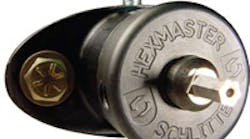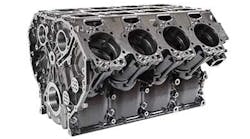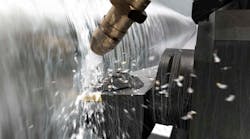Rotary broaching is an easy and economical way to accurately machine polygon forms into the inside diameter or outside diameter of parts. With rotary broaching, shops can increase profits by machining complex shapes on standard CNC lathes or mills, manual machines or screw machines without having a secondary operation. Setup is as easy as centering the tool on the work. With feeds slightly faster than drilling, complex forms can be machined quickly.
The process works equally well whether the part turns in a lathe or the holder spins in a machine and the part is fixtured because of a wobble-action that is built into the attachment.
Rotary broaching basics
Rotary broaching holders are called “orbiting heads” because of the orbiting action of the offset spindle that reduces machining forces.
The orbiting head requires a simple adjustment to bring the tool to the centerline of the part when tool length varies. Outside-diameter broaching requires a different holder and tool than inside-diameter broaching.
As the tool contacts the work, the live spindle on the holder synchronizes the tool with the work. As the tool feeds into the work, a cold-formed chip begins to flow across the front of thet ool, curling away from the cutting edge.
This process can be done on any machine tool. Basically, if a hole can be drilled with a lathe or mill, the rotary broaching process can be successful.
What can be braoched?
While the most commonly broached shapes include hexes, splines including involute splines and serrations, many other shapes can be machined including Torx, double keyways, double “D’s”, and irregular polygons.
Materials that are easily formed also can be broached.
Materials that have been successfully broached include brass, aluminum, low carbon and alloy steel, and stainless steel. Naturally, softer materials machine easier than harder materials, and small forms are easier to machine than large forms.
The difficulty of broaching is related directly to the shear strength of the material, and broaching difficulty increases as the tensile strength of the material increases and with the amount of material that is being removed.
Rotary broaching leaves a fine finish in most materials. The process is used to make machined aerospace parts,medical fasteners, valve parts and some gear shafts.
When rotary broaching a shape that must align with another part feature, it is necessary to use an attachment that is synchronized to the machine spindle. These attachments are available for screw machines, and can be made for CNC lathes with live tooling.
Rotary broaching is not recommended for use in producing long forms or for machining multiple forms in one pass, and it is not the ideal process to use in one-setup for machining both ends of a part that need to be aligned with each other. Finally, rotary broaching will not work for extremely large forms or for hardened materials.
Inside-diameter broaching
Inside-diameter rotary broaching attachments hold a tool that looks somewhat like a punch.
These holder s are commonl y used to machine an internal hex for machined fasteners.
The practical depth limit for insidediameter broaching is 1 time to 1.5 times the diameter of the machined form. That limit is due to the chips that pack in the blind hole.
While most fastener manufacturers simply leave the curled chip in the bottom of the hole, these chips may be removed with a subsequent machining step.
The set up process for inside-diameter hex broaching consists of three steps and takes seconds to complete.
Remove the bulk of the material from the form with a drill, allowing room for chips at the bottom. Alternately, an undercut can be used to part chips during the cut. For difficult materials, removing additional material will ease the process, and will create a hex or other form with rounded corners.
Chamfer the part to provide a lead for the live spindle. The chamfer can be removed later if desired.
Center the tool and feed it into the work. Feed rate depends on the material and the size of the form.
Outside-diameter broaching
Outside-diameter rotary broaching holders machine the outside diameter of a part with the desired form, although they typically are used to machine splines.
Combined with other operations, this process can create highly complex parts.
Because chips are created on the outside diameter of the part, there is little chance of the chips packing, so the length of the broached form is not limited because of the process itself.
In practice, however, outsidediameter tools have to swallow the part during machining and have a practical length limit from 1 in. to 1.5 in. depending on the holder and tooling used.
Outside-diameter broaching set-up steps include:
If the form needs to be completely cleaned-up, turn the diameter 0.001 in. to 0.00015 in larger than the broach form. Turn past the form area for tool and chip clearance.
Broach as deep as the tool and holder will allow.
An undercut beyond the form area will minimize or eliminate a bur.
Chamfer slightly smaller than the broach form to help the tool to engage the work. The chamfer can be removed later, if necessary.
Speeds, feeds and thrust forces
Because rotary broaching relies on shearing the metal in a straight line, speeds do not affect the cutting process, except for synchronizing the tool with the work.
Feeds vary with shape and size of the form as well as part material. Thrust forces for either inside-diameter or outside-diameter broaching are proportional to the cross section of the form that is being removed and the shear strength of the material.
Editor’s note: This article is based on information supplied by Schlitter Tool (www.schlittertool.com).








